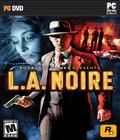A product listing by Czech publisher Cenega indicates the PC version of L.A. Noire might be arriving somewhere in November, revealing that it will pack all previously released DLCs on console.
L.A. Noire is a dark and violent detective thriller set against the backdrop of Los Angeles in the post-war years of the late 1940s and delivered with Rockstar’s signature attention to atmosphere and detail.
L.A. Noire faithfully recreates every subtle nuance of an actor’s performance, allowing players to use the classic interrogation technique of analyzing a subject’s behaviour and facial expressions in order to get to the truth. This revolutionary marriage of gameplay and technology, combined with clue-finding, and classic elements like shootouts and chases, gives players the opportunity to truly explore what it means to be a detective in the most corrupt and violent period in L.A. History.
The PC version of L.A. Noire was developed by Rockstar Leeds. It will run on a wide range of PCs and feature customization, including keyboard remapping and gamepad functionality to both optimize and customize the performance and user experience. Along with increased fidelity and improved graphical enhancements, the PC version will feature 3D support for an even greater sense of interaction and immersion within a painstakingly detailed 1940s Los Angeles.
In 1947, Los Angeles was in the middle of a massive economic boom and the world was beginning to be seduced by the glitz and glamour of Hollywood’s Golden Age. At the same time, traumatized GIs were returning from the Second World War and struggling to re-assimilate into a changed society. The result was that beneath L.A.’s glossy veneer, there was actually more corruption, deceit and murder at this time than any other period in the city’s history.
L.A. Noire is the story of Cole Phelps, a war veteran who fought in the Battle of Okinawa, the last and bloodiest battle of World War II. Awarded the Silver Star for bravery, Phelps is shipped back to the states and uses his recovery time to re-evaluate his life and what he’s achieved. He decides to join the LAPD, becoming a patrolman. Recognizing an opportunity, the department fast-tracks Phelps for success in part due to his investigative skills but mostly because of his war record – though Phelps is generally the first to admit he doesn’t want any favors for his time in the War. Phelps’ rise through the ranks of the LAPD forces him to confront the darker side of humanity, and puts him face-to-face with his own fears as a result.
The overarching story unfolds across a series of self-contained cases, each successfully solved case is a step up the ladder bringing Phelps greater success, but also bringing him closer to the true criminal underworld of L.A., until he is embroiled in events far beyond his control, revealing the truth about the dark heart of post-war Los Angeles.Throughout L.A. Noire players work on different desks in the LAPD, and instead of conventional missions or levels, gamers play specific cases from each desk. At each desk, players will be assigned a different partner, who in addition to participating in the story as it unfolds, will also assist with suggestions as to how to pursue the clues in each case as needed.
The foundation of L.A. Noire is a brand new technology called MotionScan that enables you to capture and scan every nuance of a real actor’s facial performances and put them right into the game itself. It provides a level of realism, detail, performance and emotion never seen before in a videogame, and brings them to life in a totally new way. This goes beyond the limited grid of data points delivered by traditional motion capture – these are the actual performances themselves, scanned and placed onto our digital characters. This marriage of gameplay and technology allows players for the first time ever to truly feel like a detective, reading the emotional behavior of every character. Furthermore, MotionScan lends itself perfectly to this type of game: one that focuses on characters and performances where everyone has something to hide.
More articles about L.A. Noire











 L.A. Noire is an interactive detective story set in the classic noir period of the late 1940's. L.A. Noire blends action, detection and complex storytelling and draws players into an open-ended challenge to solve a series of gruesome murders.
L.A. Noire is an interactive detective story set in the classic noir period of the late 1940's. L.A. Noire blends action, detection and complex storytelling and draws players into an open-ended challenge to solve a series of gruesome murders.